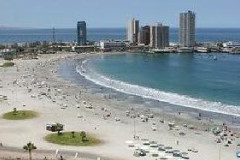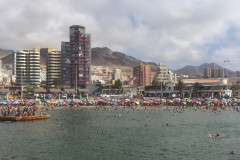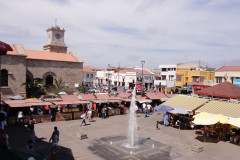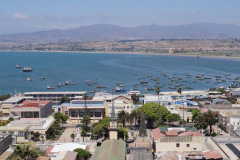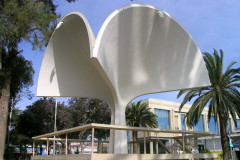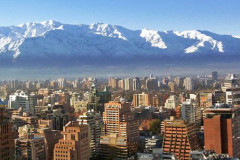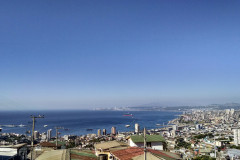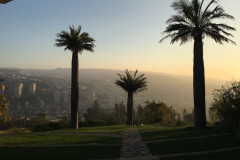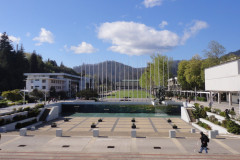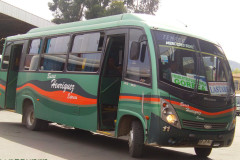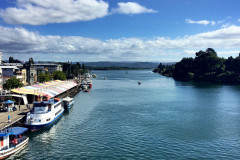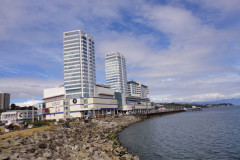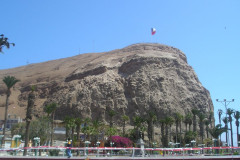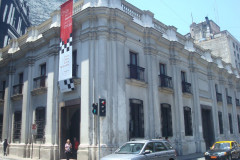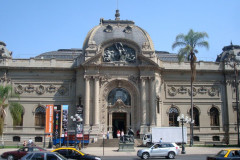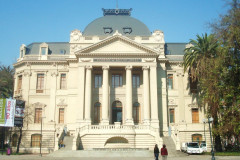Chile
Hotels
Regions (16)
Towns (15)
Places
Description
Chile , officially the Republic of Chile (Spanish: República de Chile ), is a South American country occupying a long, narrow strip of land between the Andes to the east and the Pacific Ocean to the west. It borders Peru to the north, Bolivia to the northeast, Argentina to the east, and the Drake Passage in the far south. Chilean territory includes the Pacific islands of Juan Fernández, Salas y Gómez, Desventuradas, and Easter Island in Oceania. Chile also claims about 1,250,000 square kilometres (480,000 sq mi) of Antarctica, although all claims are suspended under the Antarctic Treaty.
The arid Atacama Desert in northern Chile contains great mineral wealth, principally copper. The relatively small central area dominates in terms of population and agricultural resources, and is the cultural and political center from which Chile expanded in the late 19th century when it incorporated its northern and southern regions. Southern Chile is rich in forests and grazing lands, and features a string of volcanoes and lakes. The southern coast is a labyrinth of fjords, inlets, canals, twisting peninsulas, and islands.
Spain conquered and colonized Chile in the mid-16th century, replacing Inca rule in northern and central Chile, but failing to conquer the independent Mapuche who inhabited south-central Chile. After declaring its independence from Spain in 1818, Chile emerged in the 1830s as a relatively stable authoritarian republic. In the 19th century, Chile saw significant economic and territorial growth, ending Mapuche resistance in the 1880s and gaining its current northern territory in the War of the Pacific (1879–83) after defeating Peru and Bolivia. In the 1960s and 1970s the country experienced severe left-right political polarization and turmoil. This development culminated with the 1973 Chilean coup d'état that overthrew Salvador Allende's democratically elected left-wing government and instituted a 16-year-long right-wing military dictatorship that left more than 3,000 people dead or missing. The regime, headed by Augusto Pinochet, ended in 1990 after it lost a referendum in 1988 and was succeeded by a center-left coalition which ruled through four presidencies until 2010.
Chile is today one of South America's most stable and prosperous nations. It leads Latin American nations in rankings of human development, competitiveness, income per capita, globalization, state of peace, economic freedom, and low perception of corruption. It also ranks high regionally in sustainability of the state, and democratic development. Chile is a founding member of the United Nations, the Union of South American Nations (UNASUR) and the Community of Latin American and Caribbean States (CELAC).
Etymology
There are various theories about the origin of the word Chile. According to 17th-century Spanish chronicler Diego de Rosales, the Incas called the valley of the Aconcagua "Chili" by corruption of the name of a Picunche tribal chief ("cacique") called Tili, who ruled the area at the time of the Incan conquest in the 15th century. Another theory points to the similarity of the valley of the Aconcagua with that of the Casma Valley in Peru, where there was a town and valley named Chili.
Other theories say Chile may derive its name from a Native American word meaning either "ends of the earth" or "sea gulls"; from the Mapuche word chilli, which may mean "where the land ends;" or from the Quechua chiri, "cold", or tchili, meaning either "snow" or "the deepest point of the Earth". Another origin attributed to chilli is the onomatopoeic cheele-cheele—the Mapuche imitation of the warble of a bird locally known as trile.
The Spanish conquistadors heard about this name from the Incas, and the few survivors of Diego de Almagro's first Spanish expedition south from Peru in 1535–36 called themselves the "men of Chilli". Ultimately, Almagro is credited with the universalization of the name Chile, after naming the Mapocho valley as such. The older spelling "Chili" was in use in English until at least 1900 before switching over to "Chile."
History
Early history
Stone tool evidence indicates humans sporadically frequented the Monte Verde valley area as long as 18,500 years ago. About 10,000 years ago, migrating Native Americans settled in fertile valleys and coastal areas of what is present-day Chile. Settlement sites from very early human habitation include Monte Verde, Cueva del Milodon and the Pali Aike Crater's lava tube. The Incas briefly extended their empire into what is now northern Chile, but the Mapuche (or Araucanians as they were known by the Spaniards) successfully resisted many attempts by the Inca Empire to subjugate them, despite their lack of state organization. They fought against the Sapa Inca Tupac Yupanqui and his army. The result of the bloody three-day confrontation known as the Battle of the Maule was that the Inca conquest of the territories of Chile ended at the Maule river.
Spanish colonization
In 1520, while attempting to circumnavigate the globe, Ferdinand Magellan discovered the southern passage now named after him, the Strait of Magellan, thus becoming the first European to set foot on what is now Chile. The next Europeans to reach Chile were Diego de Almagro and his band of Spanish conquistadors, who came from Peru in 1535 seeking gold. The Spanish encountered various cultures that supported themselves principally through slash-and-burn agriculture and hunting.
The conquest of Chile began in earnest in 1540 and was carried out by Pedro de Valdivia, one of Francisco Pizarro's lieutenants, who founded the city of Santiago on 12 February 1541. Although the Spanish did not find the extensive gold and silver they sought, they recognized the agricultural potential of Chile's central valley, and Chile became part of the Spanish Empire.
Conquest took place gradually, and the Europeans suffered repeated setbacks. A massive Mapuche insurrection that began in 1553 resulted in Valdivia's death and the destruction of many of the colony's principal settlements. Subsequent major insurrections took place in 1598 and in 1655. Each time the Mapuche and other native groups revolted, the southern border of the colony was driven northward. The abolition of slavery by the Spanish crown in 1683 was done in recognition that enslaving the Mapuche intensified resistance rather than cowing them into submission. Despite royal prohibitions, relations remained strained from continual colonialist interference.
Cut off to the north by desert, to the south by the Mapuche, to the east by the Andes Mountains, and to the west by the ocean, Chile became one of the most centralized, homogeneous colonies in Spanish America. Serving as a sort of frontier garrison, the colony found itself with the mission of forestalling encroachment by both the Mapuche and Spain's European enemies, especially the British and the Dutch. Buccaneers and English adventurers menaced the colony in addition to the Mapuche, as was shown by Sir Francis Drake's 1578 raid on Valparaíso, the colony's principal port. Chile hosted one of the largest standing armies in the Americas, making it one of the most militarized of the Spanish possessions, as well as a drain on the treasury of the Viceroyalty of Peru.
The first general census was conducted by the government of Agustín de Jáuregui between 1777 and 1778; it indicated that the population consisted of 259,646 inhabitants: 73.5 percent of European descent, 7.9 percent mestizos, 8.6 percent indigenous peoples and 9.8 percent blacks. Francisco Hurtado, Governor of the province of Chiloé, conducted a census in 1784 and found the population consisted of 26,703 inhabitants, 64.4 percent of which were whites and 33.5 percent of which were natives.
The Diocese of Concepción conducted a census in areas south of the Maule river in 1812, but did not include the indigenous population or the inhabitants of the province of Chiloé. The population is estimated at 210,567, 86.1 percent of which were Spanish or of European descent, 10 percent of which were indigenous and 3.7 percent of which were mestizos, blacks and mulattos.
Independence and nation building
In 1808, Napoleon's enthronement of his brother Joseph as the Spanish King precipitated the drive by the colony for independence from Spain. A national junta in the name of Ferdinand – heir to the deposed king – was formed on 18 September 1810. The Government Junta of Chile proclaimed Chile an autonomous republic within the Spanish monarchy (in memory of this day Chile celebrates its National Day on 18 September each year).
After these events, a movement for total independence, under the command of José Miguel Carrera (one of the most renowned patriots) and his two brothers Juan José and Luis Carrera, soon gained a wider following. Spanish attempts to re-impose arbitrary rule during what was called the Reconquista led to a prolonged struggle, including infighting from Bernardo O'Higgins, who challenged Carrera's leadership.
Intermittent warfare continued until 1817. With Carrera in prison in Argentina, O'Higgins and anti-Carrera cohort José de San Martín, hero of the Argentine War of Independence, led an army that crossed the Andes into Chile and defeated the royalists. On 12 February 1818 Chile was proclaimed an independent republic. The political revolt brought little social change, however, and 19th-century Chilean society preserved the essence of the stratified colonial social structure, which was greatly influenced by family politics and the Roman Catholic Church. A strong presidency eventually emerged, but wealthy landowners remained powerful.
Chile slowly started to expand its influence and to establish its borders. By the Tantauco Treaty, the archipelago of Chiloé was incorporated in 1826. The economy began to boom due to the discovery of silver ore in Chañarcillo, and the growing trade of the port of Valparaíso, which led to conflict over maritime supremacy in the Pacific with Peru. At the same time, attempts were made to strengthen sovereignty in southern Chile intensifying penetration into Araucanía and colonizing Llanquihue with German immigrants in 1848. Through the founding of Fort Bulnes by the Schooner Ancud under the command of John Williams Wilson, the Magallanes region joined the country in 1843, while the Antofagasta area, at the time part of, Bolivia, began to fill with people.
Toward the end of the 19th century, the government in Santiago consolidated its position in the south by the Occupation of Araucanía. The Boundary treaty of 1881 between Chile and Argentina confirmed Chilean sovereignty over the Strait of Magellan. As a result of the War of the Pacific with Peru and Bolivia (1879–83), Chile expanded its territory northward by almost one-third, eliminating Bolivia's access to the Pacific, and acquired valuable nitrate deposits, the exploitation of which led to an era of national affluence. Chile had joined the stand as one of the high-income countries in South America by 1870.
The 1891 Chilean Civil War brought about a redistribution of power between the President and Congress, and Chile established a parliamentary style democracy. However, the Civil War had also been a contest between those who favored the development of local industries and powerful Chilean banking interests, particularly the House of Edwards who had strong ties to foreign investors. Soon after, the country engaged in a vastly expensive naval arms race with Argentina that nearly led to a war.
20th century
The Chilean economy partially degenerated into a system protecting the interests of a ruling oligarchy. By the 1920s, the emerging middle and working classes were powerful enough to elect a reformist president, Arturo Alessandri, whose program was frustrated by a conservative congress. In the 1920s, Marxist groups with strong popular support arose.
A military coup led by General Luis Altamirano in 1924 set off a period of political instability that lasted until 1932. Of the ten governments that held power in that period, the longest lasting was that of General Carlos Ibáñez del Campo, who briefly held power in 1925 and then again between 1927 and 1931 in what was a de facto dictatorship (although not really comparable in harshness or corruption to the type of military dictatorship that has often bedeviled the rest of Latin America).
By relinquishing power to a democratically elected successor, Ibáñez del Campo retained the respect of a large enough segment of the population to remain a viable politician for more than thirty years, in spite of the vague and shifting nature of his ideology. When constitutional rule was restored in 1932, a strong middle-class party, the Radicals, emerged. It became the key force in coalition governments for the next 20 years. During the period of Radical Party dominance (1932–52), the state increased its role in the economy. In 1952, voters returned Ibáñez del Campo to office for another six years. Jorge Alessandri succeeded Ibáñez del Campo in 1958, bringing Chilean conservatism back into power democratically for another term.
The 1964 presidential election of Christian Democrat Eduardo Frei Montalva by an absolute majority initiated a period of major reform. Under the slogan "Revolution in Liberty", the Frei administration embarked on far-reaching social and economic programs, particularly in education, housing, and agrarian reform, including rural unionization of agricultural workers. By 1967, however, Frei encountered increasing opposition from leftists, who charged that his reforms were inadequate, and from conservatives, who found them excessive. At the end of his term, Frei had not fully achieved his party's ambitious goals.
In the 1970 election, Senator Salvador Allende of the Socialist Party of Chile (then part of the "Popular Unity" coalition which included the Communists, Radicals, Social-Democrats, dissident Christian Democrats, the Popular Unitary Action Movement, and the Independent Popular Action), achieved a partial majority in a plurality of votes in a three-way contest, followed by candidates Radomiro Tomic for the Christian Democrat Party and Jorge Alessandri for the Conservative Party. Allende was not elected with an absolute majority, receiving fewer than 35 percent of votes.
The Chilean Congress conducted a runoff vote between the leading candidates, Allende and former president Jorge Alessandri and keeping with tradition, chose Allende by a vote of 153 to 35. Frei refused to form an alliance with Alessandri to oppose Allende, on the grounds that the Christian Democrats were a workers party and could not make common cause with the right-wing.
An economic depression that began in 1972 was exacerbated by capital flight, plummeting private investment, and withdrawal of bank deposits in response to Allende's socialist program. Production fell and unemployment rose. Allende adopted measures including price freezes, wage increases, and tax reforms, to increase consumer spending and redistribute income downward. Joint public-private public works projects helped reduce unemployment.[page needed] Much of the banking sector was nationalized. Many enterprises within the copper, coal, iron, nitrate, and steel industries were expropriated, nationalized, or subjected to state intervention. Industrial output increased sharply and unemployment fell during the Allende administration's first year.
Allende's program included advancement of workers' interests, replacing the judicial system with "socialist legality", nationalization of banks and forcing others to bankruptcy, and strengthening "popular militias" known as MIR. Started under former President Frei, the Popular Unity platform also called for nationalization of Chile's major copper mines in the form of a constitutional amendment. The measure was passed unanimously by Congress.
As a result, the Richard Nixon administration organized and inserted secret operatives in Chile, in order to swiftly destabilize Allende’s government. In addition, US financial pressure restricted international economic credit to Chile.
The economic problems were also exacerbated by Allende's public spending which was financed mostly by printing money and poor credit ratings given by commercial banks. Simultaneously, opposition media, politicians, business guilds and other organizations helped to accelerate a campaign of domestic political and economical destabilization, some of which was backed by the United States. By early 1973, inflation was out of control. The crippled economy was further battered by prolonged and sometimes simultaneous strikes by physicians, teachers, students, truck owners, copper workers, and the small business class. On 26 May 1973, Chile’s Supreme Court, which was opposed to Allende's government, unanimously denounced the Allende disruption of the legality of the nation. Although illegal under the Chilean constitution, the court supported and strengthened Pinochet's seizure of power.
Pinochet era (1973–1990)A military coup overthrew Allende on 11 September 1973. As the armed forces bombarded the presidential palace, Allende apparently committed suicide.[page needed][page needed] After the coup, Henry Kissinger told U.S. president Richard Nixon that the United States had "helped" the coup.
A military junta, led by General Augusto Pinochet, took control of the country. The first years of the regime were marked by human rights violations. On October 1973, at least 72 people were murdered by the Caravan of Death. According to the Rettig Report and Valech Commission, at least 2,115 were killed, and at least 27,265 were tortured (including 88 children younger than 12 years old). In 2011, Chile recognized an additional 9,800 victims, bringing the total number of killed, tortured or imprisoned for political reasons to 40,018. At the national stadium, filled with detainees, one of those tortured and killed was internationally known poet-singer Victor Jara (see "Music and Dance", below). The stadium was renamed for Jara in 2003.
A new Constitution was approved by a controversial plebiscite on 11 September 1980, and General Pinochet became president of the republic for an eight-year term. After Pinochet obtained rule of the country, several hundred committed Chilean revolutionaries joined the Sandinista army in Nicaragua, guerrilla forces in Argentina or training camps in Cuba, Eastern Europe and Northern Africa.
In the late 1980s, largely as a result of events such as the 1982 economic collapse and mass civil resistance in 1983–88, the government gradually permitted greater freedom of assembly, speech, and association, to include trade union and political activity. The government launched market-oriented reforms with Hernán Büchi as Minister of Finance. Chile moved toward a free market economy that saw an increase in domestic and foreign private investment, although the copper industry and other important mineral resources were not opened for competition. In a plebiscite on 5 October 1988, Pinochet was denied a second eight-year term as president (56% against 44%). Chileans elected a new president and the majority of members of a two-chamber congress on 14 December 1989. Christian Democrat Patricio Aylwin, the candidate of a coalition of 17 political parties called the Concertación, received an absolute majority of votes (55%). President Aylwin served from 1990 to 1994, in what was considered a transition period.
In December 1993, Christian Democrat Eduardo Frei Ruiz-Tagle, the son of previous president Eduardo Frei Montalva, led the Concertación coalition to victory with an absolute majority of votes (58%).
21st century
Frei Ruiz-Tagle was succeeded in 2000 by Socialist Ricardo Lagos, who won the presidency in an unprecedented runoff election against Joaquín Lavín of the rightist Alliance for Chile. In January 2006, Chileans elected their first female president, Michelle Bachelet Jeria, of the Socialist Party, defeating Sebastián Piñera, of the National Renewal party, extending the Concertación governance for another four years. In January 2010, Chileans elected Sebastián Piñera as the first rightist President in 20 years, defeating former President Eduardo Frei Ruiz-Tagle of the Concertación, for a four-year term succeeding Bachelet. Due to term limits, Sebastián Piñera did not stand for re-election in 2013, and his term expired in March 2014 resulting in Michelle Bachelet returning to office.
On 27 February 2010, Chile was struck by an 8.8 MW earthquake, the fifth largest ever recorded at the time. More than 500 people died (most from the ensuing tsunami) and over a million people lost their homes. The earthquake was also followed by multiple aftershocks. Initial damage estimates were in the range of US$15–30 billion, around 10 to 15 percent of Chile's real gross domestic product.
Chile achieved global recognition for the successful rescue of 33 trapped miners in 2010. On 5 August 2010 the access tunnel collapsed at the San José copper and gold mine in the Atacama Desert near Copiapó in northern Chile, trapping 33 men 700 metres (2,300 ft) below ground. A rescue effort organized by the Chilean government located the miners 17 days later. All 33 men were brought to the surface two months later on 13 October 2010 over a period of almost 24 hours, an effort that was carried on live television around the world.
Geography, climate, and environment
A long and narrow coastal Southern Cone country on the west side of the Andes Mountains, Chile stretches over 4,300 km (2,670 mi) north to south, but only 350 km (217 mi) at its widest point east to west. This encompasses a remarkable variety of climates and landscapes. It contains 756,950 square kilometres (292,260 sq mi) of land area. It is situated within the Pacific Ring of Fire. Excluding its Pacific islands and Antarctic claim, Chile lies between latitudes 17° and 56°S, and longitudes 66° and 75°W.
Chile is among the longest north-south countries in the world. If one considers only mainland territory, Chile is unique within this group in its narrowness from east to west, with the other long north-south countries (including Brazil, Russia, Canada, and the United States, among others) all being wider from east to west by a factor of more than 10. Chile also claims 1,250,000 km2 (480,000 sq mi) of Antarctica as part of its territory (Chilean Antarctic Territory). However, this latter claim is suspended under the terms of the Antarctic Treaty, of which Chile is a signatory. It is the world's southernmost country that is geographically on the mainland.
Chile controls Easter Island and Sala y Gómez Island, the easternmost islands of Polynesia, which it incorporated to its territory in 1888, and Robinson Crusoe Island, more than 600 km (370 mi) from the mainland, in the Juan Fernández Islands. Also controlled but only temporarily inhabited (by some local fishermen) are the small islands of San Ambrosio and San Felix. These islands are notable because they extend Chile's claim to territorial waters out from its coast into the Pacific Ocean.
The northern Atacama Desert contains great mineral wealth, primarily copper and nitrates. The relatively small Central Valley, which includes Santiago, dominates the country in terms of population and agricultural resources. This area is also the historical center from which Chile expanded in the late 19th century, when it integrated the northern and southern regions. Southern Chile is rich in forests, grazing lands, and features a string of volcanoes and lakes. The southern coast is a labyrinth of fjords, inlets, canals, twisting peninsulas, and islands. The Andes Mountains are located on the eastern border.
Biodiversity
The flora and fauna of Chile are characterized by a high degree of endemism, due to its particular geography. In continental Chile, the Atacama Desert in the north and the Andes mountains to the east are barriers that have led to the isolation of flora and fauna. Add to that the enormous length of Chile (over 4,300 km (2,672 mi)) and this results in a wide range of climates and environments that can be divided into three general zones: the desert provinces of the north, central Chile, and the humid regions of the south.
Flora
The native flora of Chile consists of relatively fewer species compared to the flora of other South American countries. The northernmost coastal and central region is largely barren of vegetation, approaching the most absolute desert in the world. On the slopes of the Andes, in addition to the scattered tola desert brush, grasses are found. The central valley is characterized by several species of cacti, the hardy espinos, the Chilean pine, the southern beeches and the copihue, a red bell-shaped flower that is Chile's national flower.
In southern Chile, south of the Biobío River, heavy precipitation has produced dense forests of laurels, magnolias, and various species of conifers and beeches, which become smaller and more stunted to the south. The cold temperatures and winds of the extreme south preclude heavy forestation. Grassland is found in Atlantic Chile (in Patagonia). Much of the Chilean flora is distinct from that of neighboring Argentina, indicating that the Andean barrier existed during its formation.
Just over 3,000 species of fungi are recorded in Chile, but this number is far from complete. The true total number of fungal species occurring in Chile is likely to be far higher, given the generally accepted estimate that only about 7 percent of all fungi worldwide have so far been discovered. Although the amount of available information is still very small, a first effort has been made to estimate the number of fungal species endemic to Chile, and 1995 species have been tentatively identified as possible endemics of the country.
Fauna
Chile's geographical isolation has restricted the immigration of faunal life, so that only a few of the many distinctive South American animals are found. Among the larger mammals are the puma or cougar, the llama-like guanaco and the fox-like chilla. In the forest region, several types of marsupials and a small deer known as the pudu are found.
There are many species of small birds, but most of the larger common Latin American types are absent. Few freshwater fish are native, but North American trout have been successfully introduced into the Andean lakes. Owing to the vicinity of the Humboldt Current, ocean waters abound with fish and other forms of marine life, which in turn support a rich variety of waterfowl, including several penguins. Whales are abundant, and some six species of seals are found in the area.
-
Puma in Chile (cougar)
-
A guanaco in northern Chile
-
Chilla fox, common in the region
-
Pudú in Chile
-
Andean condor (Vultur gryphus), the national bird of Chile
Topography
Chile is located along a highly seismic and volcanic zone, part of the Pacific Ring of Fire, due to the subduction of the Nazca and Antarctic plates in the South American plate.
Late Paleozoic, 251 million years ago, Chile belonged to the continental block called Gondwana. It was just a depression accumulated marine sediments began to rise at the end of the Mesozoic, 66 million years ago, due to the collision between the Nazca and South American plates, resulting in the Andes. The territory would be shaped by millions of years due to the folding of the rocks, forming the current relief.
The Chilean relief consists of the central depression, which crosses the country longitudinally, flanked by two mountain ranges that make up about 80% of the territory: the Andes mountains to the east-natural border with Bolivia and Argentina, with its most alton 18 located on the Nevado Ojos del Salado, at 6891.3 m, the highest volcano in the world, in the region of Atacama and Coastal Range west-minor height from the Andes, with its highest point located on the hill Vicuña Mackenna, at 3114 meters, located in the Sierra Vicuña Mackenna, the south of Antofagasta. Among the coastal mountains and the Pacific is a series of coastal plains, of variable length, which allow the settlement of coastal towns and big ports. Some areas of the plains territories encompass territory east of the Andes, and the Patagonian steppes and Magellan, or are high plateaus surrounded by high mountain ranges, such as the Altiplano or Puna de Atacama.
The Far North is the area between the northern boundary of the country and the parallel 26° S, covering the first three regions. It is characterized by the presence of the Atacama desert, the most arid in the world. The desert is fragmented by streams that originate in the area known as the pampas Tamarugal. The Andes, split in two and whose eastern arm runs Bolivia, has a high altitude and volcanic activity, which has allowed the formation of the Andean altiplano and salt structures as the Salar de Atacama, due to the gradual accumulation of sediments over time.
To the south is the Norte Chico, extending to the Aconcagua river. Los Andes begin to decrease its altitude to the south and closer to the coast, reaching 90 km away at the height of Illapel, the narrowest part of the Chilean territory. The two mountain ranges intersect, virtually eliminating the intermediate depression. The existence of rivers flowing through the territory allows the formation of transverse valleys, where agriculture has developed strongly in recent times, while the coastal plains begin to expand.
Ten highest peaks of Chile Name Altitude (m) Nevado Ojos del Salado1 6891,3 Nevado Tres Cruces1 6758 Llullaillaco1 6739 Incahuasi1 6638 Tupungato1 6565 Ata Volcano1 6501 Cerro El Muerto1 6488 Parinacota2 6342 Pomerape2 6282 Los Patos1 6239 Note:1 shared with Argentina, 2 shared with Bolivia.The Central area is the most populated region of the country. The coastal plains are wide and allow the establishment of cities and ports along the Pacific, while the coastal mountains down its height. The Andes maintains altitudes above 6000m but descend slowly starts approaching the 4000 meters on average. The intermediate depression reappears becoming a fertile valley that allows agricultural development and human settlement, due to sediment accumulation. To the south, the Cordillera de la Costa reappears in the range of Nahuelbuta while glacial sediments originate a series of lakes in the area of La Frontera.
Patagonia extends from within Reloncavi, at the height of parallel 41 ° S, to the south. During the last glaciation, this area was covered by ice that strongly eroded Chilean relief structures. As a result, the intermediate depression sinks in the sea, while the coastal mountains rise to a series of archipelagos, such as Chiloé and the Chonos, disappearing in Taitao peninsula, in the parallel 47 ° S. The Andes mountain range loses height and erosion caused by the action of glaciers has caused fjords.
East of the Andes, on the continent, or north of it, on the island of Tierra del Fuego are located relatively flat plains, which in the Strait of Magellan cover large areas.
The Andes, as he had done previously Cordillera de la Costa, begins to break in the ocean causing a myriad of islands and islets and disappear into it, sinking and reappearing in the Southern Antilles arc and then the Antarctic Peninsula, where it is called Antartandes, in the Chilean Antarctic Territory, lying between the meridians 53 ° W and 90 ° W.
In the middle of the Pacific, the country has sovereignty over several islands of volcanic origin, collectively known as Insular Chile. Of these, we highlight the archipelago of Juan Fernandez and Easter Island, which is located in the fracture zone between the Nazca plate and the Pacific plate known as East Pacific Rise.
Hydrography
Ten longest rivers of Chile Name Length (km) Loa 440 Bío Bío 380 Baker 370 Copiapó 292 Maipo 250 Yelcho-Futaleufú 246 Maule 240 Palena 240 Toltén 231 Huasco 230 Note: All lengths exclusively through Chilean territory.Due to the characteristics of the territory, Chile is crossed by numerous rivers generally short in length and with low torrential flow. They commonly extend from the Andes to the Pacific Ocean, flowing in an East to West direction.
Because of the desert, in the Norte Grande there are only short endorheic character streams, except for the river Loa, the longest in the country 440 km. In the high valleys, wetland areas generate Chungará Lake, located at 4500 meters above sea level. It and the river Lauca are shared with Bolivia, as well as the Lluta.
In the center-north of the country, the number of rivers that form valleys of agricultural importance increases. Noteworthy are the Elqui with 75 km long, 142 km Aconcagua, Maipo with 250 km and its tributary, the Mapocho with 110 km, and Maule with 240 km. Their waters mainly flow from Andean snowmelt in the summer and winter rains. The major lakes in this area are the artificial lake Rapel, the Colbun Maule lagoon and the lagoon of La Laja.
Health
The Ministry of Health (Minsal) is the cabinet-level administrative office in charge of planning, directing, coordinating, executing, controlling and informing the public health policies formulated by the President of Chile. The National Health Fund (Fonasa), created in 1979, is the financial entity entrusted to collect, manage and distribute state funds for health in Chile. It is funded by the public. All employees pay 7 percent of their monthly income to the fund.
Fonasa is part of the NHSS and has executive power through the Ministry of Health (Chile). Its headquarters are in Santiago and decentralized public service is conducted by various Regional Offices. More than 12 million beneficiaries benefit from Fonasa. Beneficiaries can also opt for more costly private insurance through Isapre. Hospitals in Chile are mainly located in the Santiago Metropolitan Region.
Culture
Pablo Neruda and Gabriela Mistral, Nobel Prize recipients in literature (1971 and 1945)From the period between early agricultural settlements and up to the late pre-Hispanic period, northern Chile was a region of Andean culture that was influenced by altiplano traditions spreading to the coastal valleys of the north, while southern regions were areas of Mapuche cultural activities. Throughout the colonial period following the conquest, and during the early Republican period, the country's culture was dominated by the Spanish. Other European influences, primarily English, French, and German began in the 19th century and have continued to this day. German migrants influenced the Bavarian style rural architecture and cuisine in the south of Chile in cities such as Valdivia, Frutillar, Puerto Varas, Osorno, Temuco, Puerto Octay, Llanquihue, Faja Maisan, Pitrufquén, Victoria, Pucón and Puerto Montt.
Music and dance
Music in Chile ranges from folkloric, popular and classical music. Its large geography generates different musical styles in the north, center and south of the country, including also Easter Island and Mapuche music. The national dance is the cueca. Another form of traditional Chilean song, though not a dance, is the tonada. Arising from music imported by the Spanish colonists, it is distinguished from the cueca by an intermediate melodic section and a more prominent melody.
Between 1950 and 1970 appears a rebirth in folk music leading by groups such as Los de Ramón, Los Cuatro Huasos and Los Huasos Quincheros, among others with composers such as Raúl de Ramón, Violeta Parra and others. In the mid-1960s native musical forms were revitalized by the Parra family with the Nueva canción Chilena, which was associated with political activists and reformers such as Víctor Jara, Inti-Illimani, and Quilapayún. Other important folk singer and researcher on folklore and Chilean ethnography, is Margot Loyola. Also many Chilean rock bands like Los Jaivas, Los Prisioneros, La Ley, and Los Tres have reached international success. In February, annual music festivals are held in Viña del Mar.
Cuisine
Chilean cuisine is a reflection of the country's topographical variety, featuring an assortment of seafood, beef, fruits, and vegetables. Traditional recipes include asado, cazuela, empanadas, humitas, pastel de choclo, pastel de papas, curanto and sopaipillas. Crudos is an example of the mixture of culinary contributions from the various ethnic influences in Chile. The raw minced llama, heavy use of shellfish and rice bread were taken from native Quechua Andean cuisine, (although now beef brought to Chile by Europeans is also used in place of the llama meat), lemon and onions were brought by the Spanish colonists, and the use of mayonnaise and yogurt was introduced by German immigrants, as was beer.
Folklore
The folklore of Chile, cultural and demographic characteristics of the country, is the result of mixture of Spanish and Amerindian elements that occurred during the colonial period.. Due to cultural and historical reasons, they are classified and distinguished four major areas in the country: Northern Areas, central, southern and south. Most of the traditions of the culture of Chile have a festive purpose, but some, such as dances and ceremonies have religious components.
MythologyChilean mythology, is the mythology and beliefs of the Folklore of Chile.
This includes Chilote mythology, Rapa Nui mythology and Mapuche mythology.
Cinema
The film originated in Valparaíso on 26 May 1902 with the premiere of the documentary Exercise General Fire Brigade, the first film completely filmed and processed in the country. In the following decades, marked milestones The deck of Death (or The Enigma of Lord Street) (1916), considered the first film Chilean story, The transmission of presidential (1920), the first animated film in the country, and North and South (1934), the first sound film of Chile.
Cultural heritage
The cultural heritage of Chile consists, first, of their intangible heritage, composed of various cultural events, such as visual arts, crafts, dances, holidays, cuisine, games, music and traditions, and, secondly, by its tangible, consists of those buildings, objects and sites of archaeological, architectural, traditional, artistic, ethnographic, folkloric, historical, religious or technological scattered through Chilean territory, among them, those goods are declared World Heritage Site by UNESCO, in accordance with the provisions of the Convention concerning the Protection of World Cultural and Natural Heritage of 1972, ratified by Chile in 1980. These cultural sites are the Rapa Nui National Park (1995), the Churches of Chiloé (2000), the historical district of the port city of Valparaíso (2003), Humberstone and Santa Laura Saltpeter Works (2005) and the mining city Sewell (2006).
In 1999 the Cultural Heritage Day was established as a way to honour and commemorate Chiles cultural heritage. It is an official national holiday celebrated in May every year.

